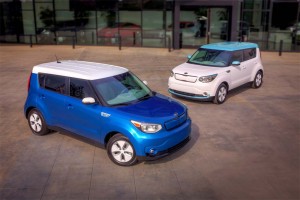
Kia's first battery-car, the Soul EV, goes on sale during the third quarter, but only in a handful of markets.
Korean carmaker Kia is the latest to plug-into the growing market for battery-electric vehicles, introducing the all-new 2015 Kia Soul EV at the Chicago Auto Show.
The Soul is one of three battery-based models Kia is showing at this year’s event in the Windy City, the maker also rolling out an updated version of its Optima Hybrid sedan, as well as the new Niro Hybrid Concept.
Most major automakers have, or soon plan to add plug-based vehicles to their U.S. model lines – at least in part due to the strict new Zero-Emission Vehicle, or ZEV standards going into effect in California and a handful of other states. But while sales have fallen well short of proponents’ expectations, plug-in hybrids and pure battery-electric vehicles, or BEVs, generated just short of 100,000 sales last year, an all-time record.
(For more on the growing plug-based vehicle market, Click Here.)
“The new Soul EV is at the forefront of Kia’s ‘Clean Mobility’ program and will offer an even more environmentally friendly option to our customers when it goes on sale later this year,” said Orth Hedrick, vice president of product planning, KMA, noting that the BEV will reach showrooms during the third quarter of this year as a 2015 model.
The maker initially plans to offer the Soul EV in a handful of select coastal markets including California, Oregon, New York, New Jersey and Maryland, states with the largest EV fleets and charger networks – and with ZEV mandates. But it promises it will “offer the vehicle in other markets in the near future as infrastructure and demand grow.”
(Click Here to check out the 10 finalists — and winner — for Green Car Tech of the Year.)
The Soul EV is expected to deliver somewhere between 80 and 100 miles of range per charge – the EPA not yet signing off on final numbers for the vehicle which draws power from 27 kilowatt-hours of batteries mounted beneath the floor.
That’s enough to produce 109 horsepower and 210 pound-feet of torque, launching the battery-car from 0 to 60 in less than 12 seconds. The Soul EV has a top speed of 90 mph.
Kia notes that the lithium-polymer pack has one of the industry’s highest energy-density levels – the amount of power stored in a given mass – at 200 Wh/kg, or watt-hours per kilogram. That allows the vehicle to deliver more range with a smaller, lighter battery.
The battery-based Soul will allow drivers to choose from four different modes, each increasing the amount of energy recaptured through regenerative braking. At the max, the brakes can transform about 12% of that kinetic energy back into electricity stored in the vehicle’s battery pack.
With a standard, 120-volt outlet, the 2015 Kia Soul EV would require as much as 24 hours to recharge, though that drops to as little as five hours with a 240-volt charger. A so-called Level III 480-volt DC charging system can be used to give an 80% “fill-up” in as little as 33 minutes.
(Nissan becomes first automaker to ever sell more than 100,000 battery-cars. Click Herefor the story.)
Kia is partnering with three charger vendors, Bosch, Leviton and AeroVironment to give buyers a choice of the best pack for their personal needs.
The basic design of the 2015 model is nearly identical to the stock Kia Soul but for a few notable details, including a larger grille housing the car’s charger ports. There are unique accent trim, project headlamps, LED positioning and taillamps and other details, along with special 16-inch wheels and low-rolling resistance tires.
The maker claims it helped boost range by improving the standard-issue Soul’s aerodynamics. It has also built in a “Virtual Engine Sound System” to make it easier for pedestrians to hear the EV approaching when it’s moving at less than 12 mph or when shifted into reverse.
The Kia Soul EV will feature a unique version of the maker’s UVO eServices which will provide special downloadable apps that can, among other things, help owners find nearby battery chargers, and determine whether they can travel to a specific destination on the current charge.
Unlike the gas-version, the Soul EV will come standard with such features as navigation, rear camera, hands-free Bluetooth and a 6.6 kW onboard charger.
Pricing will be released closer to the battery-car’s launch.
